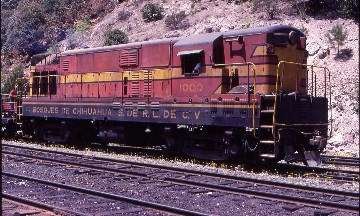
Back when I was about twelve, I was looking through my brother Bruce's Train Magazines and in 1974 there was an issue about Fairbanks and Morris {FM} engines. In the middle of that issue there was a center spread of two FM diesels in factory demo paint scheme on an obscure logging railroad in Mexico called the Bosques de Chihuahua. I looked in my atlas and could not find any reference to where this railroad was and there was no information in the magazine's Second Section to its location. I just filed it back away in my mind but never forgot that vivid picture. In early 1988, I received a Let's Travel Tour brochure in the mail for trips both on the Bosques de Chihuahua and Destination Nacozari. I signed up for both. The Bosque trip was either a three day or ten day trip which included Copper Canyon. With limited time because of work and coaching Varsity Baseball with Paul Collick I took the three day trip which worked perfectly with the triweekly schedule of the Sunset Limited. On May 11th I took a San Diegan to Los Angeles and met up with our tour group who were traveling by train. We all were boarded in one coach together on the Sunset Limited and left Los Angeles on time. Every single rider got to have their own set of seats and we ran on time across every division of the Southern Pacific. The trip was very enjoyable and uneventful as I met all of my new traveling companions. We arrived in El Paso on time on May 12th and a bus picked us up to take us to the Holiday Inn for our one night stay there.
May 13th, 1988May 13th, 1988 The next morning following a group breakfast with additional details about today's trip given, we boarded buses to take us to Mexico. We crossed the Rio Grande River entering Mexico and Cuidad Juarez. We traveled down the narrow streets at one point going nine blocks down a one way street going the wrong way with the current of traffic dodging us. I guessed the bus driver thought my bus is bigger than your car so get out of my way. It worked but I will never forget the semi who played chicken with us. We arrived at the Juarez train station and the Chihuahua and Pacific {CHP} mixed train not ready to leave yet. We had a 7:30 A.M. departure time but the power was not on the train yet. Well I was a happy rail fan on this morning as in the yard switching was a National Railroad of Mexico {NdeM} RSD-12 road switcher putting on a great show for my camera before the overnight train from Mexico City pulled in which was followed by the power for our Mixed Train 32.
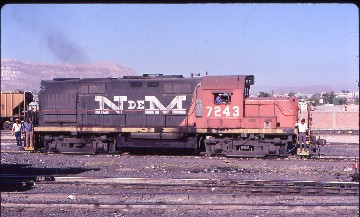
My experience and reading about trains in Mexico is that trains here may have a published schedule in an employee timetable but will leave if and when the crew is ready. Since the whole railroad is run by timetable and train orders anyway it seems to work out fine. This kind of railroading is far different from anything in the United States and I must say is far more interesting. It's not some dispatcher calling the shots from a few states away but each line's individual employees all working together as a team providing a safe operation of the trains.
CHP Mixed Train 32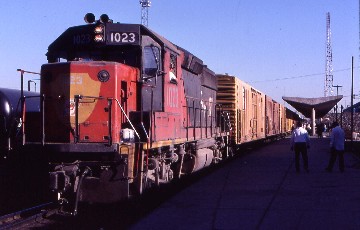
We left one hour twenty minutes late but the good news is we are finally starting our rail adventure in Mexico. We were riding the old Mexican Northwestern completed in 1909 between Juarez and La Junta. It was heavily involved with Poncho Villa's forces but that is a story for later. We passed through South Juarez some of which looks like the United States except the traffic signs and signals giving it away as Mexico before we headed through an area of shacks and squatter's settlements on the outskirts of town. We passed by the lines of former box cars that track workers and families live in before we crossed the NdeM mainline and headed out into the Chihuahua Desert. The desert here was very sandy and low bushes with the train heading up a slight grade. Our train consists of a CHP GP-38-2, twelve freight cars, our Primera air condition coach, our open window coach, two regular coaches for the regular riders, the railroad's pay car complete with guards and a CHP caboose. This was my first mixed train ever and after about thirty minutes I wondered if we would stop to pick anything up along the way before Neuvo Casa Grande. My hopes are not too high as there is nothing out here except the desert. We passed through places like Mesquite, Medanos and Placa KB-490. There may be only a sign or telephone box to these locations but I did see footprints leading away from the tracks at each of these spots.
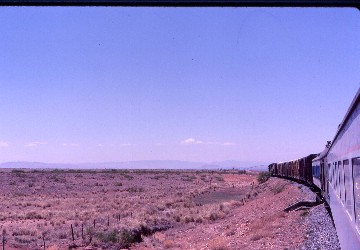
We turned directly west past Barreal, San Blas and north of Guzman I saw the dry lake of Laguna de Guzman. Here we turned south and the scenery turned more into Basin and Range geography reminding me of Central Nevada or home on the range. Off in the distance, I saw a herd of cattle which looked as if they belonged here with no fences and I wondered where they got their water from. We continued to pass through places in the middle of nowhere like Urrutia, then at Sabinal a surprise, we stop at a modern looking platform with a cover to keep the sun off of the passengers which today there is a family boarding. We continued the slight climb past Santa Sofia and at San Pedro there was a station where our crew got new orders. Besides the station there are houses for the railroad workers mainly for those who work on the tracks. The design of these dwellings are like those along the Sonora Baja and California. Maybe it was a common design throughout Mexico. This line is actually the way I pictured it in my mind when I first started thinking about it after I had booked the trip. We passed a sign further on down the rails that read Summit and unless you are paying attention to the terrain you would have never noticed that we were at the top of a grade or there was even a sign for it. I guessed I am just an observant person. Off in the distance I saw green and realized we were entering the valley of Neuvo Casa Grande and its water source is the Rio Casa Grande. We passed Placa KB-366 and further on the train stopped at Corralitios. When the engine cut off, a few of us detrained track side and took a few pictures. The engine went by us down the siding, picked up two water tank cars and run back by us, we reboarded and off we went south. With the mixed train pick up fantasy completed we proceeded to Victoria where we had orders to hold the mainline and a freight train would pass us using the siding.
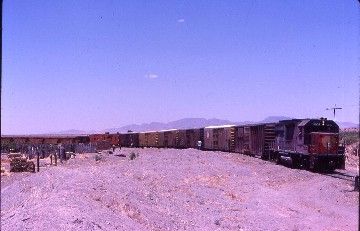
All the photographers got off and waited out in the warm sun for the freight train to show up. When it did the single unit GP-40 pulling the freight train was in the old CHP red paint scheme and everyone clicked away to their hearts content.
Back on board we entered the green zone of the valley and farmers were out tending their crops with a few ranchers taking care of their sheep. We passed Section Hidalgo and then proceeded at the highest speed of the day soon arriving Neuvo Casa Grande today's destination. Waiting for us was the northbound diesel hauled Autovias with a rare GP-28 with FM trucks doing the yard switching.

We detrained our two cars which were then cut off and spotted. The GP-28 added some cars to the mixed train. The mixed train engine got a brother to assist it for the trip across the mountain country to the south. When all is ready, both trains departed for their destinations and our group walked over to the shops for a tour. Here we saw more Autovias. These were self propelled rail cars which are having their motors removed so they can become trailers to be hauled by diesels to continue their lives. Several engines were on hand to photograph as well as a CHP FM H-12-44, that was lettered SCOP for use in a movie. The reason I keep coming to Mexico is to see the locomotives here which are no longer in existence in the United States.

After the tour we visited a local store for some Coca-Cola which tasted a little saltier than the USA version before we took a bus to the Hacienda Hotel which will be our base for the next two nights. I relaxed for a while in my room before having a group dinner prior to retiring for the night.
CHP Special Train May 14,1988It was a bright sunny morning as I walked through the hotel's courtyard to this morning's group breakfast. Following a nice breakfast and going over today's itinerary, we took the bus down to the train station to our special CHP train consisting of two itinerary GP-38 locomotives, two cabooses, our group's two coaches and an open gondola car for fresh air and the unobstructed views for pictures. Where there is water there is agriculture, no water desert. We were traveling directly south into the upper reaches of the Casa Grande Valley. The train made a quick trip up the tracks passing Guadalupe, Don Luis, Col. Madero and Anchondo. We pulled into Mata Ortiz and saw the old foundations of the old steam locomotive shops.
South of Mata Ortiz the valley narrowed into a canyon reminding me of Meadow Valley Wash in Nevada. We started our climb into the Sierra Madre mountain range leaving the desert behind for the higher elevations and timber country. It was a gradual climb with the train traveling through one vegetational zone after another. This is one reason why I love train travel is that I get to see many different kinds of trees and plants up close almost to my touch. We passed through Rucio, Cuevitas and then Riba where the grade increased to 2%. Near Riba we did our first photo runby of the day where a fire had burnt away all of the plant growth. I next rode up in the cupola of the caboose as the train twisted and turned to Aquaja where we did our second Photo Runby of the day with the train rounding a nice curve.

From there I rode up in the engine in the cab of the lead locomotive. I stood behind the engineer who looked back and smiled at me. He then stood up, took my hand lead me to the engineer seat, puts my right hand on the throttle and I put my left hand on the brake. He pats me on the back and now I was running the train. I saw some range cattle on the track so I blew the horn and they ran off. I felt the wheels beginning to slip so I reached for the sander just as he did. I turned it on and the problem was solved. He left me alone running the train by myself for about ten minutes. After those ten uneventful minutes, I decided to return to being a passenger with me thanking him in both English and Spanish. I always wanted to be an engineer, thanks to one very nice CHP engineer I got my chance. Some dreams and fantasies do come true.
I went out to the front porch of the GP-38 sat down and hang my feet over the pilot. The train was now really climbing, gaining elevation and was rapidly climbing up the side wall of the canyon. Trees were changing into pines as the train negotiated several horseshoe curves. We passed the telegraph shack at Bellavista followed by the passing siding at Caballo. Off to the right it was a long way down to the stream and to the left I could not see the top of the ridge line. This is mountain railroading very different from the desert running of yesterday but when you think of the Chihuahua Pacifico it brings up an image of Copper Canyon, mountains, bridges and tunnels. This line is just another part of that whole image and I am so glad to be experiencing it. As we arrived at Cumbre, we crossed a switch with a line running off to the left. That is the reason I am here as that is the start of the Bosque de Chihuahua Railway. We pulled into the yard to await the Bosque to come and get us. This allowed us to look around Cumbre so I first explored the station building then walked down the tracks to the south end of the yard. I saw an abandoned tunnel which brings me to the Poncho Villa story I eluded to earlier. In 1914 Villa's troops stole a passenger train then set it on fire inside the Cumbres Tunnel destroying it. Because of the fire a new tunnel had to be built and is located east of the former tunnel. This act of violence was the worst incident of the ten year Mexican revolution as Poncho Villa's troops battled the Federal Troops. Depending on who you talk to, Villa is either a "Saint" or I use a nice word "Sinner", but he did play a colorful part in Mexican history.
The Bosque connection crossed over the new line on a fill with the CHP going through it in a tunnel. I then got an idea. Since the Bosque has not arrived yet I would climb up on the fill then get up on the hillside and get a picture of it dropping into Cumbre. Just as I had started climbing, two voices asked, "Where are you going?" I told them of my plan and they asked to join me so the three of us climbed up the hill overlooking the tracks. Twenty minutes later we were rewarded with the Bosque FM H-16-44 leading a homemade open car with benches.
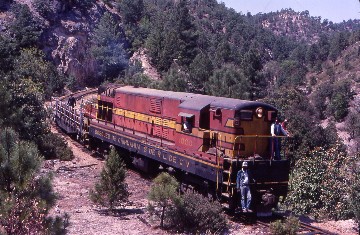
We returned to the Cumbre yard just as the H-16-44 arrived and a picture with both trains were staged. We got the word that the northbound was due in about ten minutes so all the photographers got into position and got ready. I shot the mixed train then get all three trains in the yard at Cumbre, a rare occurrence at this location.
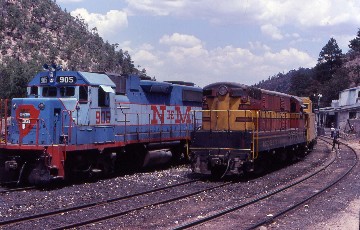
We boarded our train for the 33 kilometer ride over the Bosques de Chihuahua. We were the second passenger train over the line and the last official revenue move. The train was the H-12-44, the Bosque open car, the CHP open car and a caboose. We backed down the Cumbre Yard past the switch before we started forward up their line passing behind the station, over the CHP tracks and started up the side of the canyon where at its head we made a horseshoe curve to gain attitude. We then made a hard left now high above Cumbres and climbed into the mountains. We followed a ridge through the heavily forested slopes before crossing over a divide. We descended on a more gentle grade and it was announced that we would do a Photo Runby.

We detrained as the train descended another horseshoe curve and was then down in the valley below us with everyone shooting pictures to their heart's content. The train retraced its path to pick us all up and then we went right to where we had just photographed the train. This was a most interesting way to do a runby and a special thanks goes to Bill Farmer who planned it. During the day, clouds had moved in and formed over the mountains. Like we needed to have it, a rain shower forced everyone to seek cover into the cabooses to protect their camera gear. You never think rain and Mexico in the same thought but here I am in the pine trees and that is something else that people do not think about in Mexico. Say the line, "Where do you find pine trees?" and I guarantee you that no person would say Mexico or Chihuahua. The train kept going through the rain storm and just as we arrived at Mesa de Hurricane, the rain ceased.
We had an hour to explore this place. The lumber mill was closed and that is the reason that the railroad is going out of business. With an all weather highway just put in, trucks now take the timber making this railroad obsolete. So it is on a sad note that I do my one and only time photography here but this trip will always be a happy memory because I made it here. I walked into the diesel shop and found the other FM H-16-44 tucked away inside along with a very nice business car. I learned that the SW-1 switch engine is in Madera so I did not get a chance to shot a picture of the only SW-1 that was exported. Outside is a VW passenger van on railroad wheels. Is this a rail bus or what? There was a lot of machinery laying around and just as I finished my tour the hour was up and I headed back to my waiting train.
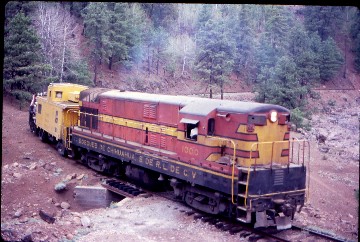
We retraced our route back to Cumbre doing two more photo runbys on the way there. It is so quiet here that you can hear your heart beating. The FM produced some great engine sounds. The 33 kilometers went by quickly and all too soon our round trip over the Bosque de Chihuahua was over as we arrived at Cumbre. The FM ran around our train and took off their open car. Our engines hooked onto our train and off we went into the evening twilight. I went up to the front engine and enjoyed the rest of the trip back to Nuevo Casa Grande on the front pilot thinking what a fantastic day it was. Thanks to the Chihuahua Pacific, Bosque de Chihuahua and Let's Travel Tours for this great experience.
The Trip Home May 15-17, 1988Those of us on the three day trip were bussed back to El Paso from Casa Grande. At nine in the morning we boarded a very nice Mexican bus that took us north on a different route than the railroad took to Juarez. We went straight north to the US Border before turning east to Juarez. The bus sped north and after leaving the river valley it was nothing but desert. My mind thought that I would rather be on a train but I have to be on this dam bus in order to get to my train. We stopped at a store to get some beer to go along with our box lunches. The beer made the ride a little bit better and about an hour later we crossed first the CHP tracks then the NdeM tracks before we turned north for Juarez. We were now on the main highway and in no time we were at the Rio Grande River waiting to enter the United States. The US Custom agent walked on the bus to do a pre inspection. One of our passengers had a bottle of rum that he had bought before the trip and will have to pay duty on it if he brings it back into Texas. The officer said there is no tax on an empty bottle and he gave him ten minutes to decide what to do. "Anyone want a drink?" The bottle was passed around the bus to the six passengers and within six minutes the bottle was duty free. The custom agent returned with, "Is everyone a US citizen. Ok! Have a great day and is there any trash I can remove for you?" I got dropped off at the Amtrak depot and found my westbound train was running right on time. I boarded the train and shared a seat with a guy from Mexico who spoke no English. This was no problem for me and we had a great trip back to California together. A quick trip on a San Diegan and I went straight to MacArthur coaching Varsity Baseball with Collick to the first championship in school's history. But then what is history? To some this trip would have been. To others every trip I take is. What is your take on that subject?